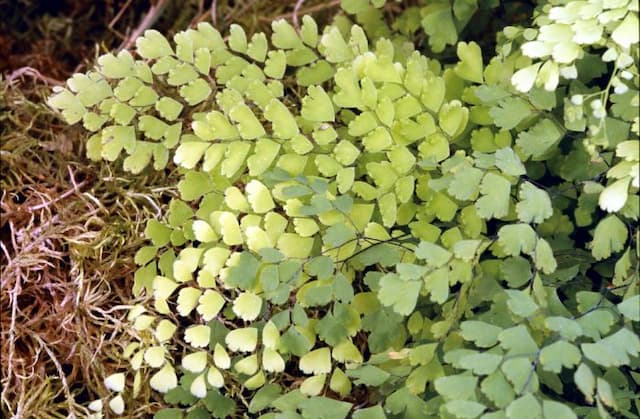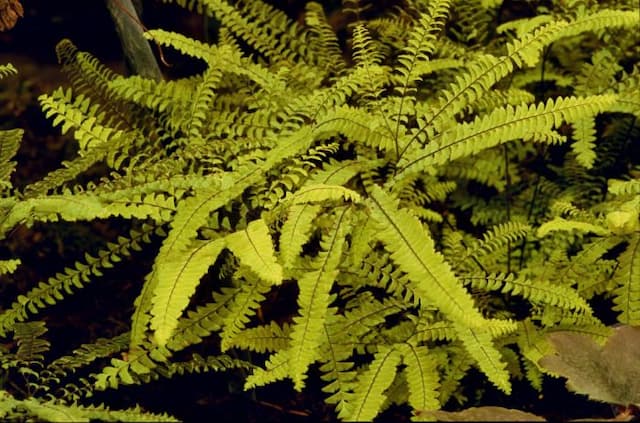Mairis's Hardy Maidenhair Fern Adiantum × mairisii

ABOUT
Adiantum × mairisii, commonly known as Mairis's maidenhair fern, is a delicate and attractive plant. It features an array of light green, triangular fronds that cascade down gracefully, giving it a soft, feathery appearance. These fronds are composed of multiple leaflets, which are small, fan-shaped, and arranged alternately along slender, black or dark brown stems that add a striking contrast to the light green foliage. The overall look of Mairis's maidenhair fern is airy and elegant, with a natural arching habit that gives it a refined and lush presence. The texture of the fronds is smooth, and they have a tendency to be held aloft on the thin, wiry stems, creating a gentle, waving movement in the breeze. This fern is a popular choice for adding a touch of delicacy and sophisticated greenery to shaded garden areas or indoor spaces, where its refined appearance can be admired up close.
About this plant
 Names
NamesFamily
Pteridaceae
Synonyms
Mairis's Maidenhair Fern, Mairis's Hardy Maidenhair Fern, Hybrid Maidenhair Fern
Common names
Adiantum mairisii
 Toxicity
ToxicityTo humans
Maidenhair fern, which includes Adiantum × mairisii, is not known to be toxic to humans. Therefore, there are no specific symptoms of poisoning associated with this plant, as ingestion of reasonable quantities is not expected to cause harm.
To pets
Maidenhair fern, which includes Adiantum × mairisii, is also not considered toxic to pets. It should not cause poisoning symptoms if ingested by dogs, cats, or other household pets. However, as with any non-food plant, ingestion of plant material may potentially cause mild stomach upset in some animals.
 Characteristics
CharacteristicsLife cycle
Perennials
Foliage type
Evergreen
Color of leaves
Green
Height
1-2 feet (30-60 cm)
Spread
1-2 feet (30-60 cm)
Plant type
Fern
Hardiness zones
8-10
Native area
Hybrid origin
Benefits
 General Benefits
General Benefits- Decorative Appeal: Adiantum × mairisii, commonly known as Mairis's maidenhair fern, has delicate, feathery fronds that add a touch of elegance and grace to any indoor or outdoor space.
- Humidity Tolerance: It thrives in humid environments, making it an ideal plant for bathrooms and kitchens where moisture levels are higher.
- Shade Loving: This fern is well-suited for shady areas of the garden or home, allowing those with less direct sunlight to grow lush, green plants.
- Erosion Control: When planted outdoors, it can help prevent soil erosion due to its spreading habit and dense foliage.
- Low Maintenance: Mairis's maidenhair fern requires minimal care once established, needing only consistent moisture and avoidance of direct sunlight.
- Therapeutic Presence: The simple act of tending to and observing the growth of this plant can have a soothing and relaxing effect, which can contribute to mental well-being.
 Medical Properties
Medical PropertiesThis plant is not used for medical purposes.
 Air-purifying Qualities
Air-purifying QualitiesThis plant is not specifically known for air purifying qualities.
 Other Uses
Other Uses- Decorative purposes in terrariums due to Adiantum × mairisii's visual appeal and humidity preferences.
- Used in bridal bouquets and wedding decorations for its delicate and elegant foliage.
- Incorporated into art installations for its unique form and the aesthetic notion of fragility it represents.
- Utilized in photography, especially macro photography, to illustrate the intricacy of plant structures.
- Adiantum × mairisii is often used in miniature gardens to create a sense of depth and lushness.
- It can serve as a natural dye source, with its various parts potentially providing subtle color variations.
- Used as an educational tool in botany classes for studying fern reproduction and spore propagation.
- In ornamental fish tanks, providing aesthetic value and a natural hiding place for small fish and invertebrates.
- As a living mulch in outdoor shaded gardens, helping to retain soil moisture and prevent weed growth.
- Underutilized, but possible use in sustainable packaging design, where the leaves could inspire patterns or textures.
Interesting Facts
 Feng Shui
Feng ShuiThe Maidenhair Fern is not used in Feng Shui practice.
 Zodiac Sign Compitability
Zodiac Sign CompitabilityThe Maidenhair Fern is not used in astrology practice.
 Plant Symbolism
Plant Symbolism- Delicacy: Adiantum × mairisii, commonly known as Maidenhair Fern, has thin, delicate fronds which commonly symbolize fragility and finesse.
- Secret Bond: The intricate network of fronds can represent hidden emotions or a bond that is not immediately apparent to outsiders.
- Purity: Ferns are often associated with purity due to their fresh green foliage and the clean, intricate patterns of their leaves.
- Eternal Youth: The Maidenhair Fern, with its lush, evergreen fronds, can be a symbol of eternal youth and the desire to remain young at heart.
- New Beginnings: As ferns unfurl their new fronds in a process known as "fiddleheading," they often symbolize new beginnings or a fresh start.
- Health: Historically, ferns like the Maidenhair Fern have been used in traditional medicine, and as such, they can symbolize health and well-being.
 Water
WaterMairisii Fern requires consistent moisture, meaning the soil should be kept damp but not waterlogged. Water the plant sufficiently every one to two weeks, depending on the humidity and temperature of its environment, allowing the top inch of soil to dry out slightly before rewatering. Use lukewarm water to avoid shock and aim for about 16 to 32 ounces (0.12 to 0.25 gallons) per watering session for a medium-sized pot. If the air is very dry, especially during winter months, increase the frequency to maintain the necessary moisture levels. Always avoid letting the Mairisii Fern sit in standing water, as this can lead to root rot.
 Light
LightMairisii Fern thrives in bright, indirect light. It should be placed in a location where it can receive plenty of diffused sunlight, such as near a north- or east-facing window. Direct afternoon sun can scorch its delicate fronds, so if only a south- or west-facing window is available, use a sheer curtain to filter the light. This plant also adapts well to fluorescent light, making it suitable for office environments or rooms with less natural light.
 Temperature
TemperatureMairisii Fern prefers a temperature range of 60°F to 75°F for optimal growth, making it suitable for most indoor settings. It can tolerate a minimum temperature of about 50°F but should be protected from cold drafts and sudden temperature changes. The ideal conditions also include average household humidity levels; if the air is too dry, consider using a humidifier or placing a tray of water near the plant to help increase the moisture in the air.
 Pruning
PruningPruning Mairisii Fern is primarily for removing dead or yellowing fronds to maintain the plant's appearance and encourage healthy growth. Light pruning can be done periodically throughout the year as needed. The best time for more extensive pruning is during the spring, which is the start of the growing season. Prune sparingly, as this fern does not usually require extensive cutting back, and always use clean, sharp scissors or pruning shears.
 Cleaning
CleaningAs needed
 Soil
SoilMairisi's Fern prefers a well-draining soil mix with a pH of 6.0 to 7.5. A mix of peat, pine bark, and perlite in equal parts creates an ideal substrate that holds moisture yet allows excess water to drain, preventing root rot.
 Repotting
RepottingMairisi's Fern should be repotted every 2-3 years, or when it becomes root-bound. It's best to repot during the spring season, which gives the plant time to establish in the new pot before winter.
 Humidity & Misting
Humidity & MistingMairisi's Fern thrives in high humidity, ideally between 60-80%. Maintaining this level of humidity will help prevent the delicate fronds from drying out and turning brown.
 Suitable locations
Suitable locationsIndoor
Place Mairisi's Fern in bright, indirect light with high humidity.
Outdoor
Keep Mairisi's Fern in shade to partial sun, protect from harsh elements.
Hardiness zone
9-11 USDA
 Life cycle
Life cycleAs a fern, Mairis's Maidenhair (Adiantum × mairisii) begins its life cycle with the release of spores from mature fronds, the plant's leaf-like structures. These spores germinate in moist conditions to form a heart-shaped gametophyte, which is a small, green, photosynthetic structure that contains both male and female reproductive organs. Fertilization occurs when sperm from the male organs swim to the female organs in the presence of water, leading to the development of a diploid zygote. The zygote then develops into a new sporophyte, the typical fern plant, which initially grows from the gametophyte tissue and eventually becomes an independent plant. As the Mairis's Maidenhair matures, it produces fronds with sori, clusters of spore-producing structures, on their undersides, which complete the reproductive cycle. The mature fern continues to grow and spread, often forming large, attractive clumps of delicate, fan-shaped fronds with dark, wiry stems.
 Propogation
PropogationPropogation time
Spring-Early Summer
Mairis’s Hardy Maidenhair Fern, Adiantum × mairisii, is often propagated through division, which is the splitting of its rhizomes. The best time to propagate these ferns by division is in the spring, as this is when the plant is coming out of dormancy and beginning a period of active growth. To propagate by division, the fern should be carefully lifted from its container or garden location, and the root ball should be gently teased apart or cut with a sharp, clean knife into smaller sections, ensuring that each division has a portion of the rhizome and fronds. These divisions can then be potted in separate containers with well-draining, fern-appropriate potting mix, or planted directly in the garden if the weather conditions are suitable. It is important to maintain consistent moisture for the newly transplanted divisions while they establish themselves over the following weeks, and to keep them in a dappled shade location similar to their native environment.




